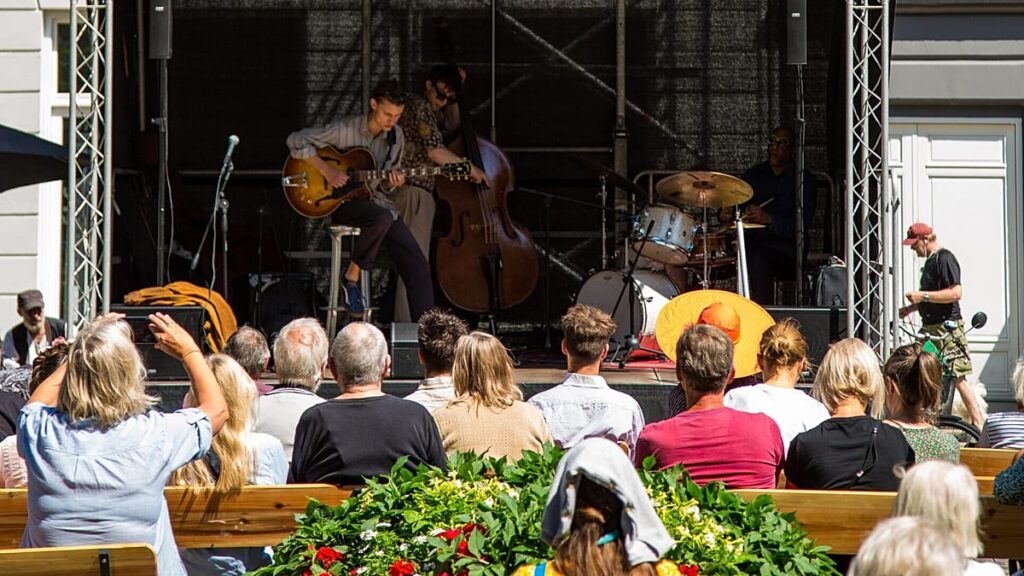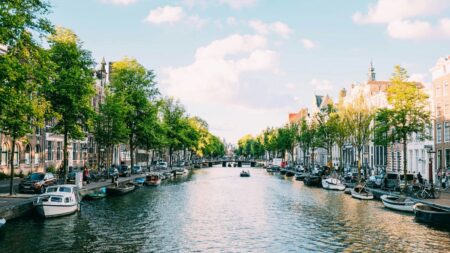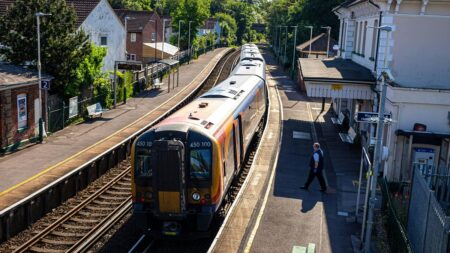Wine glasses clink, silverware rattles and chairs scrape against the wood flooring. There’s an energy in the room that you’ll find at most restaurants on a Friday night.
The tables are full of beautiful dishes – fresh oysters with sorrel and green chilli, thin-sliced redfish with dashi and seasonal plums, truffle-flecked duck breast atop puréed potatoes.
This is Epicurus, one of Copenhagen’s best new dining destinations. But as flawless as the food is, everyone in the room seems to understand that dinner is the appetiser.
If you walk through the dining space, with its high ceilings and fine wood accents, you find the main course: a hidden jazz hall with cinema seating, world-class sound technology and its own cocktail bar.
Equal parts restaurant, bar and jazz club, Epicurus reflects an often understated legacy that’s shaped Copenhagen for nearly a century.
Beneath the city’s clean designs, Michelin stars and cycle lanes lies a countercultural undercurrent that has been expressed through jazz since at least the 1950s.
Once a haven for American musicians seeking creative freedom, the Danish capital today has evolved into one of the world’s most dynamic jazz hubs, where decades-old clubs, cutting-edge venues and open-air festivals keep the music alive night after night.
How Copenhagen became Europe’s unexpected jazz capital
In the pantheon of great jazz cities, New Orleans and New York rank first, then Paris, Tokyo and London. But few cities in Europe share Copenhagen’s deep connection to the art form.
In the 1950s and ’60s, the city became a refuge for American musicians seeking respect and creative space – especially Black artists coming up at the dawn of the civil rights movement, a time still defined by segregation and economic inequality.
Saxophonist Stan Getz moved here. So did Dexter Gordon, Chet Baker, Quincy Jones and pianist Kenny Drew, who today lies buried in Copenhagen.
“Jazz is the most perfect example of democracy in action – a coexistence of freedom and discipline,” says pianist and composer Niels Lan Doky. “I think that may have helped attract American artists to Denmark. It’s also why Danes like it.”
Many of those musicians may have felt something in Denmark they rarely experienced at home.
“I’ve asked a lot of people, ‘Why did all these great musicians come here?’” Lan Doky tells me. “There are different theories, but many say they really appreciated the Danish audiences. They felt treated like artists, as opposed to entertainers.”
What began as escape eventually became collaboration across countries and cultures, Lan Doky adds. The Americans played with local musicians, taught younger Danes and helped build a community that continues to draw talent from around the world.
In Denmark, underground music became a post-war renaissance
Jazz had already taken root in Denmark decades earlier.
During the Nazi occupation, from the late 1930s through the early 1940s, Joseph Goebbels declared it “degenerate music”. Danes played it anyway in cellars and secret venues and music became an act of resistance. After the war, the movement went public.
In 1959, Jazzhus Montmartre opened in the city centre and became Europe’s answer to the Village Vanguard in New York. On any given night, Dexter Gordon might be onstage while Miles Davis watched from the crowd.
From its founding until it closed in 1995, the club welcomed some of the world’s greatest musicians and served as a training ground for Denmark’s best and brightest.
“Living in Copenhagen … I have probably worked in more different contexts than if I had stayed in New York where I might have got musically locked in with a set group of musicians,” Drew wrote in the liner notes to his album “Morning.”
The city hasn’t forgotten those years, either.
In the Sluseholmen district, seven streets are named for the American musicians who lived and played here: Richard Boone, Kenny Drew, Dexter Gordon, Thad Jones, Oscar Pettiford, Ben Webster and Ernie Wilkins.
Where to experience jazz in Copenhagen today
For travellers and fans of jazz history, it’s easy to plug into what’s happening in the city’s music scene today.
Thanks in part to Lan Doky, the Jazzhus Montmartre was revived in its original location. A few streets away, the intimate, 100-seat La Fontaine – the city’s oldest jazz bar – hosts regular jam sessions that tend to attract a diverse crowd, says Lan Doky.
“It’s been there forever,” he says, adding that it’s popular for young and emerging artists. “Everyone who plays in Copenhagen ends up there at some point.”
Charlie Scott’s, on Skindergade in the city centre, offers equally informal sets and an easygoing local crowd.
And then there’s Epicurus. Inside the Rosenborg Annexe, a 110-year-old, National Romantic building across from Rosenborg Castle, the crowd usually arrives dressed to the nines – blue blazers, high heels, sequined skirts. Here, Lan Doky curates rotating, four-week residencies, promising experiences “that can only be heard here,” he says.
“When the same musicians and the same repertoire stay in the same room that long, the music evolves and goes in different directions.”
Visitors can easily experience that spontaneous evolution firsthand. Twice a year, large-scale festivals transform the city into a living jazz venue, with performances spanning from intimate clubs to open-air stages.
Every July, the Copenhagen Jazz Festival fills 120 venues with more than 1,500 concerts in just ten days. Any venue can sign up to host events, which range from ticketed performances to free outdoor sets and even jazz cruises on the canals.
In February, Vinterjazz helps Denmark emerge from the winter cold with performances across the country. More than 600 concerts take place, from Aalborg to Aarhus.
All these venues and events give travellers a reason to return to Copenhagen.
“In jazz, there’s never the same thing twice,” as Lan Doky puts it. “Even if you play the same tune, it will never be the same.”
Read the full article here












